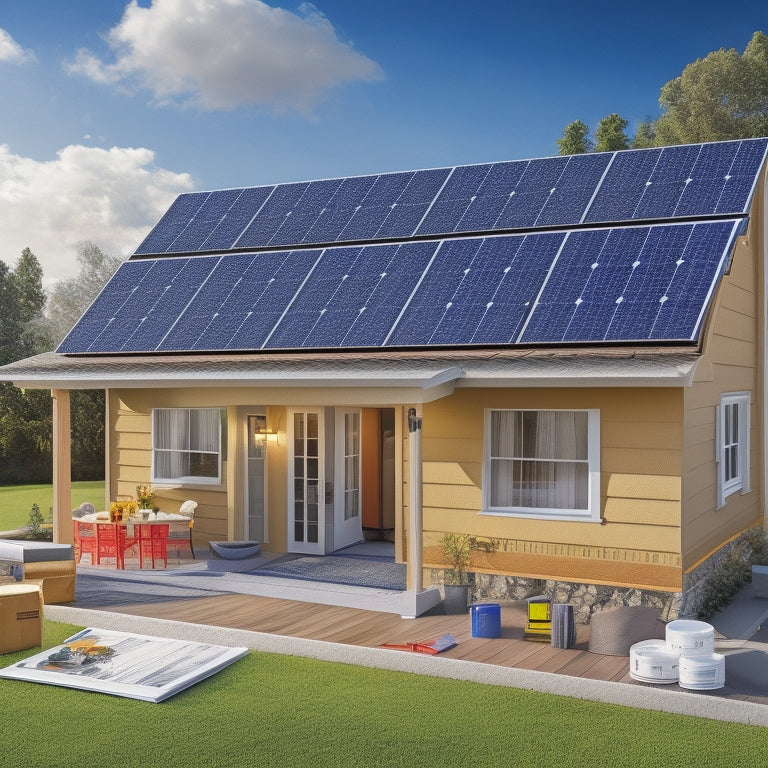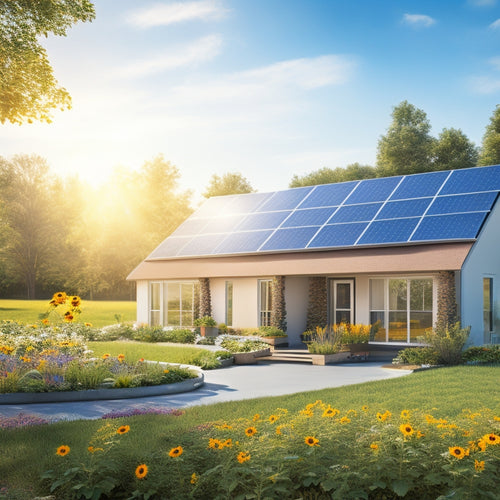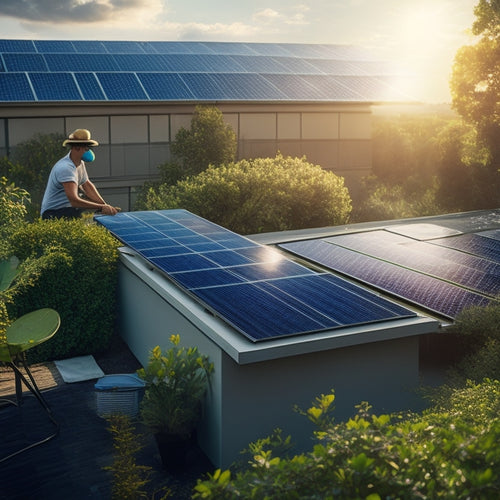
7 Essential Steps to Calculate Solar Watts Needed for House
Share
To calculate the solar watts needed for your house, you'll need to follow seven essential steps. First, determine your energy requirements by reviewing past electricity bills and evaluating your appliances' energy consumption. Next, evaluate your roof's solar potential by analyzing its orientation, local solar irradiance, and dimensions. Calculate your home's energy load, then determine the total solar wattage needed by considering factors like energy usage, roof size, and local climate. Choose the right solar panel type based on efficiency, durability, and weather resistance. Consider local climate and shading, and consult with experts to verify your calculations. By following these steps, you'll get a clear depiction of your solar energy needs and be one step closer to a cost-effective system that meets your specific requirements.
Key Takeaways
- Determine your home's energy requirements by reviewing past electricity bills and assessing individual appliance energy consumption.
- Assess your roof's solar potential by evaluating its orientation, size, and obstructions that may affect panel placement and energy production.
- Calculate your home's energy load by summing the total wattage of appliances, lighting, and HVAC systems and multiplying by daily usage hours.
- Consider key factors like energy usage, roof size, local climate, shading, and system efficiency to calculate the total solar wattage needed.
- Consult with experts to verify calculations and ensure a accurate assessment of your solar energy needs.
Determine Your Energy Requirements
To accurately calculate the required solar watts for your house, you need to determine your energy requirements. This involves evaluating your energy consumption patterns and identifying areas where you can optimize appliance efficiency.
Start by reviewing your past electricity bills to understand your average daily energy usage in kilowatt-hours (kWh). Make a list of all your appliances, including their wattage ratings and usage hours per day. This will help you calculate their individual energy consumption.
Next, consider the efficiency of your appliances. Look for the Energy Star rating, which indicates energy efficiency. You can also investigate ways to reduce energy consumption, such as replacing incandescent bulbs with LEDs or using power strips to eliminate standby power consumption.
Assess Your Roof's Solar Potential
Now that you've determined your energy requirements, you're ready to assess your roof's solar potential. This involves evaluating your roof's orientation, size, and shading to determine how much solar energy it can utilize.
Start by identifying your roof's orientation, which can greatly impact its solar potential. A south-facing roof receives the most sunlight, while east- and west-facing roofs receive about 75% of the sunlight a south-facing roof receives. North-facing roofs receive the least amount of sunlight.
Next, consider the size of your roof and the available space for solar panels. Measure the length and width of your roof to determine the total square footage.
Then, identify any obstructions, such as skylights, vents, or chimneys, that may affect the placement of solar panels.
Calculate Your Home's Energy Load
As you prepare to shift to a solar-powered home, calculating your home's energy load is an important step in determining the required solar watts. This involves identifying the total amount of electricity your home consumes daily, which will help you size your solar panel system accurately.
Start by gathering your past electricity bills to determine your average daily energy consumption in kilowatt-hours (kWh). Next, make a list of all your appliances, lighting, and HVAC systems, along with their respective wattages. Calculate the total wattage of each item and multiply it by the number of hours you use it daily. Add up the total watt-hours (Wh) and divide it by 1000 to get your daily energy load in kWh.
Optimizing energy efficiency through load management is vital to minimize your energy load. Identify areas where you can reduce energy consumption, such as replacing incandescent bulbs with LEDs or upgrading to energy-efficient appliances.
Choose the Right Solar Panel Type
Your solar panel system's performance hinges on the type of solar panels you choose, so it's essential to select the right ones for your specific needs.
When choosing a solar panel type, you'll want to take into account two key factors: solar panel efficiency and panel durability.
Solar panel efficiency refers to the panel's ability to convert sunlight into electricity. Higher-efficiency panels produce more power per hour of sunlight, making them ideal for smaller rooftops or areas with limited sunlight.
Panel durability is also vital, as it directly affects the system's lifespan and overall performance. Look for panels with a durable construction, weather-resistant materials, and a proven track record of withstanding various environmental conditions.
A durable panel will guarantee consistent energy production over its lifetime, typically 25 years or more.
Consider Local Climate and Shading
Determine how local climate and shading conditions impact your solar panel system's performance.
You'll want to assess the amount of solar exposure your roof receives throughout the year, taking into account seasonal variations and weather patterns. A shading analysis will help identify any obstacles, such as trees or neighboring buildings, that could reduce your system's energy efficiency.
Climate factors, like temperature and humidity, also affect performance, so it's crucial to take into account these when selecting your solar panel system.
Additionally, you'll need to factor in local regulations and roof orientation to guarantee ideal energy production.
For instance, if you live in an area with frequent overcast days, you may need to adjust your system's size or configuration to compensate.
Moreover, understanding the environmental impact of your system and exploring available solar incentives can help you make an informed decision.
Calculate Total Solar Wattage Needed
Five key factors will influence the total solar wattage you need for your house: your energy usage, roof size, local climate, shading conditions, and desired system efficiency.
These factors will determine how much solar energy your system needs to generate to meet your electricity consumption needs.
You'll need to calculate your total daily energy usage in watt-hours (Wh) by adding up the energy consumption of all your appliances, lights, and devices.
Then, consider your roof size and the available space for solar panels. Your local climate and shading conditions will also impact the system's performance, so factor in the amount of sunlight your roof receives daily.
Lastly, decide on a desired system efficiency, which is the percentage of sunlight converted into usable electricity. A higher efficiency system will require fewer solar panels, but may be more expensive.
Verify Your Calculations With Experts
You've completed your solar wattage calculations, but it's essential to verify your work with experts to guarantee accuracy.
Check the qualifications of the experts you consult, and make certain to consult multiple sources to get a well-rounded viewpoint.
Check Expert Qualifications
Before finalizing your solar panel installation, it's vital to verify your calculations with specialists in the field, as even minor miscalculations can lead to significant consequences.
You'll want to make certain that the specialists you consult have the necessary solar panel certifications and installation proficiency. Check if they're certified by reputable organizations, such as the North American Board of Certified Energy Practitioners (NABCEP). This certification guarantees they've the knowledge and skills to design and install a safe and efficient solar panel system.
When checking specialist qualifications, ask about their experience with installations similar to yours. Have they worked on projects with similar roof sizes, orientations, and energy requirements?
Do they've a track record of successful installations with minimal callbacks or issues? It's pivotal to verify their proficiency in designing systems that meet local building codes and regulations.
Consult Multiple Sources
To guarantee the accuracy of your solar panel installation, verifying your calculations with multiple experts is an essential step.
You've checked the qualifications of potential experts, now it's time to consult with them. Reach out to at least three solar panel installers and ask them to review your calculations. This will help you identify any potential errors or oversights that could impact the performance of your solar panel system.
When consulting with these experts, be sure to ask about their experience with similar projects and their understanding of local solar incentives.
Also, inquire about their installation costs and how they factor in variables like roof size and energy efficiency. By getting multiple viewpoints, you'll gain a more thorough understanding of your solar panel needs and be better equipped to make informed decisions.
Take note of any discrepancies in the calculations and ask for explanations. This will help you identify potential areas of concern and confirm that your solar panel installation meets your energy needs while staying within your budget.
Verify Calculation Methods
Get down to business with your experts by asking them to walk you through their calculation methods, making certain you're on the same page. This is vital to verify calculation accuracy and avoid any potential discrepancies.
Don't hesitate to ask questions or seek clarification on any steps you're unsure about. Remember, it's better to be safe than sorry when it comes to calculating solar watts for your house.
During the expert consultation, pay attention to the formulas and variables used in their calculations. Confirm that the experts consider all relevant factors, such as your location's solar irradiance, roof size, and energy efficiency.
Take note of any assumptions made and how they justify them. This will help you understand the reasoning behind their calculations and identify any potential flaws.
Frequently Asked Questions
Can I Install Solar Panels on a Rented Property?
You can investigate solar lease options for a rented property, but first, understand your tenant rights and negotiate with your landlord to guarantee a mutually beneficial agreement that works for both parties.
How Long Does a Typical Solar Panel Installation Take?
You're enthusiastic to utilize the sun's power, but first, you're wondering how long it'll take to get your solar panels up and running - the installation timeline can vary, but typically, the installation process takes around 3-5 days to a few weeks, depending on factors like system size and complexity.
Do Solar Panels Work During a Power Outage?
During a power outage, you'll need a battery backup system to enjoy continued solar panel functionality; without it, your system won't provide power, as safety protocols shut it down to prevent backfeeding energy into the grid.
Are Solar Panels Resistant to Hail and Extreme Weather?
Like a shield, you'll want solar panels that can withstand Mother Nature's fury! You'll be relieved to know that most modern panels are designed to resist hail damage and boast impressive weather durability, withstanding extreme conditions like 2.5 cm hailstones and 240 km/h winds.
Can I Sell Excess Energy Back to the Grid?
You can sell excess energy back to the grid through net metering, earning energy credits that offset your utility bills; this benefit allows you to capitalize on your solar investment, reducing your reliance on traditional power sources.
Conclusion
As you traverse the path to solar-powered bliss, remember that calculating your solar watts is like charting a course through treacherous waters. You've carefully plotted your energy requirements, assessed your roof's solar potential, and considered the local climate's twists and turns. Now, with your calculations in hand, you've reached the shores of a sustainable future. But before dropping anchor, verify your figures with the experts to confirm a smooth, energy-efficient expedition ahead.
Related Posts
-

Home Solar Systems for Environmental Impact
Home solar systems markedly reduce your carbon footprint by utilizing renewable energy. By adopting solar energy, you...
-

Green Ways to Maintain Solar Panels
To maintain your solar panels sustainably, start with regular inspections to catch potential issues early, enhancing ...
-

How to Reduce Home Energy Bills
To reduce your home energy bills, start by investing in energy-efficient appliances and upgrading your insulation. Lo...


